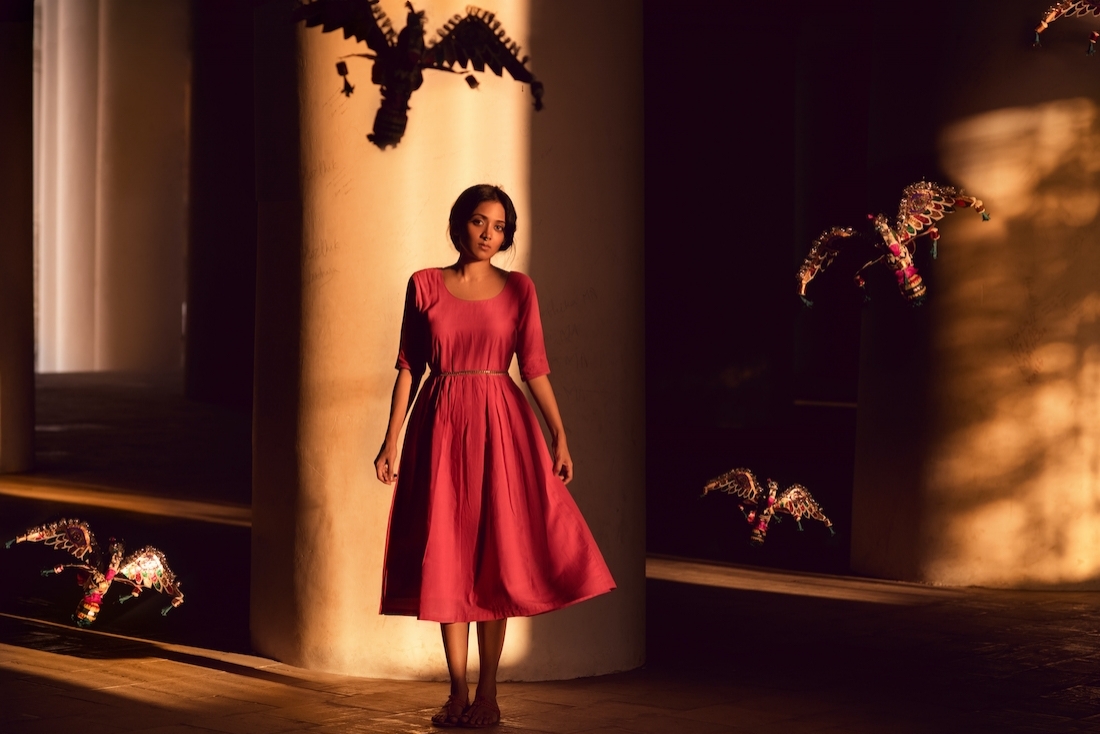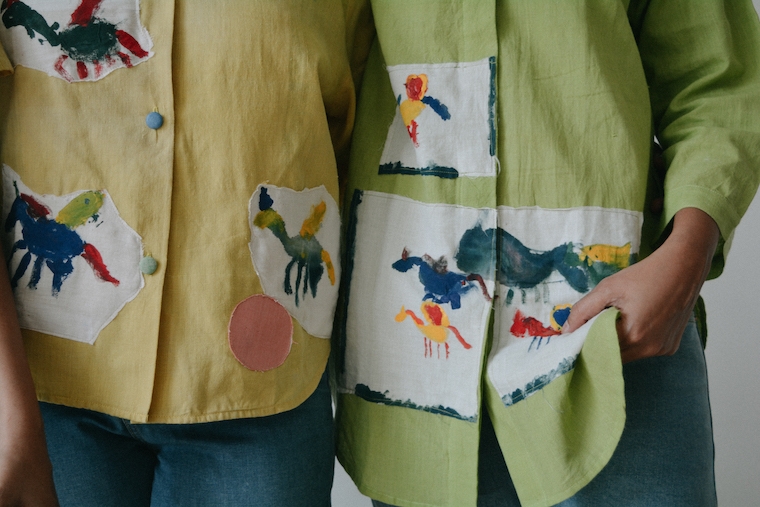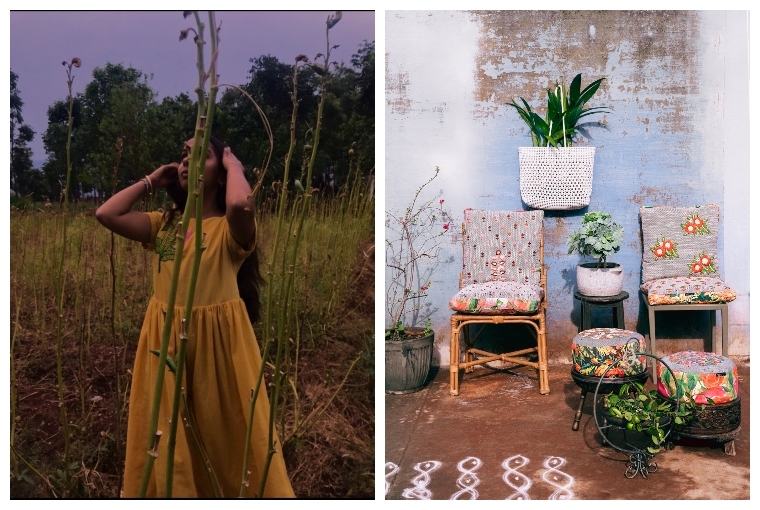

The mustard yellow of turmeric, the earthy maroon of the soil, the striking blues of the sky, and the vivid greens of the hills — Kalki, a design studio, finds its muse in these familiar colours, which have embraced us all during our growing up years. Using textile as their medium, Kalki’s work is a conversation between the cultural and the contemporary. They seek to be reflective of the wearer’s identity and roots, and to be their voice. The studio works with local weavers and craftsmen right from sourcing the material to finished product delivery, and promotes mindful consumption. Playing with textures and hues, the clothes crafted by Kalki are ultimately nostalgia. ‘I am made and remade continually’ is the first thing you would see on their website. This philosophy reflects on how each one of us metamorphose constantly, and how each garment is constantly reinterpreted and reworked.
Founder Karunya Rajan was born and brought up in Mettupalayam, near Ooty. She has an engineering degree and is a business graduate from Anna University. However, she doesn't have any academic history with fashion, and hasn't been associated with design in a technical manner. We connected with her to know more about her studio, the journey, and the thought behind some of their collections.
The Studio
Kalki began as my personal passion project a few years ago. I was bored with the colours that were available in the market. I was used to the colours from the South, where the men and women in my family wore the rich colours of the Kanjeevaram silks and cotton sarees. In India, we are exposed to so many colours, richness and vibrancy. More bold and earthy tones, and at the same time subtle and personal shades. I got bored of the monotony in the market which saw a lot of influence of whites and pastel blues. Hence, I started this as a fun experiment, I started making clothes for myself and then slowly for my friends. I spent most of my childhood in Mettupalayam, and I began noticing that the people here use clothes and the colours to express their identity. It's like their voice. It talks about where they are from and their culture, all at once. I’ve come to realise that these colours have always influenced me subconsciously. So in Kalki I explore this childhood, and reflect on where we grew up and how we grew up. I use it as a space where I get to initiate conversation.
The Philosophy
Kalki as a space connects me to who I am, and it brings me back to who I am. This is something which we tend to forget sometimes. It's a self learning space. There is no fixed notion of this is me, or this is Kalki. I associate Kalki as me. And I also feel every other person is me, because I feel all of us are made of the same elements. Everyday you keep evolving, everyday you keep questioning, and ultimately, everyday you change. I don’t want to fit into a commercial cloth-making fashion label. I didn't aspire to become a designer, I just wanted to make really unique clothes, clothes that have a voice and an identity. So we don’t really dwell on brand positioning and other such things, and we don’t mass produce — it's always a capsule and limited production.
Gandhigram
Initially, I worked with local weavers, and then I chanced upon Gandhigram, which is in Dindigul. It is a community which functions as a circular economy. My father and grandfather are agriculturists, they engage in imports and exports of potatoes. When they do business, farmers don't exist as individuals. So, Gandhigram resonated with me because of two reasons. Firstly, the fabric they had — its texture, the feel, the colour, and the overall experience, reminded me of the sarees that my mother used to wear, and the coloured shirts that my father and grandfather used to wear. I instantly connected with the fabric. And secondly, the fact that they worked as a community there. It didn't just stop with the weavers, their children were taken care of by the trust and so on.
The Textile
Clothes are something which touch our skin. Are we even aware of this when we pick something everyday and wear it? We tend to not notice it, we are not conscious about it. Clothes are indispensable. They are a basic need. I feel that we can use clothes to enhance our way of living and invoke our sensorial emotional values, roots and culture as well. That's how I look at textiles, the colours evoke something in us. There is a reason why, when you go to a hilltop, or when you see a lot of green, you feel something within you. Then, why are people hesitant to wear colours like green? When you eat good food, it benefits your health. In the same way, I feel that when you wear clothes, and when you’re aware of the texture and what the colour does to you, the experience is heightened, and it leads to a better quality of life.

The Creative Process
Brainstorming and ideation at Kalki has always been very organic. I try a lot of things before I confirm on something. Sometimes I just know in one go that this is what I want to do, these are the colours that I want to use and this is how it has to be done. It is very organic, there is a lot of freewheeling sensibility. It is intuitive, and reflective of the aesthetic that surrounds the studio. The studio is an ancestral space by itself, it is my grandfather’s. It still has red oxide flooring, oil paintings, and has this Wes Anderson vibe with the pinks and the pista greens. We have a farm as well, which is also very much a part of Kalki’s aesthetic. Everything just happens with the flow, and inspiration comes naturally to me -- be it some childhood connection or my surroundings.
Madurai and Sungudi
I wanted to introduce contemporary clothes in the earthy colours, the maroons, the ramar greens, the colours that we see in the old Kanjeevaram sarees. The first collection that I did with Gandhigram was Madurai. Madurai was chosen as a background because it has a lot of history with regards to culture, and parts of the city still hold on to this culture. We did one part of the shoot at Nayakar Mahal, which was built by an Italian. If you see the colours and architecture, they brought their Italian philosophy in terms of the domes and arches, but you can see a lot of traces of Madurai in terms of the yellows, the red oxide, the cement plasters and the carvings. So the place kind of spoke what I wanted to convey. And we also explored shooting with school children, and the rural roads of Madurai as well — I wanted to bring in the naiveness, a little bit of child’s play.
The collection Sungudi was a conversation between the two cultures of Madurai and Saurashtra. People from Saurashtra came to Madurai and they used this craft as a way to earn their living. There was a migration. I saw a lot of depth in this phenomenon, where the people from Saurashtra taught the locals, settled, and made the city their home. And all this while, they were able to sustain their identity. So, while I have only seen Sungudi sarees, which are a household regular, I wanted to give a contemporary twist to this and worked with three colours — red, pink and maroon. I collaborated with Nivedita Sumbramanyam, a children’s books author as I wanted to talk about the cultural context of Madurai and bring in Tamil literature and history. Also incorporate the role of the Vaigai river as a significant element of the city, as seen in various folk tales.

The Challenges
In terms of moving the products, people are hesitant to buy pinks, browns, reds and yellows. Only when people wear it, do they understand. They have a tactile experience. Hence, when Sungudi went to the stores, it was a sellout. People need to experience the clothes we make. We often struggle because we need to convince stores and outlets to display our work. However, the satisfaction of even one or two people buying from Kalki, wearing a piece of clothing, identifying with it, and saying that it really reminded them of their childhood, makes us feel content. It’s all about these conversations, and the connections. The intention behind anything that we make here in Kalki has a lot of emotional value attached to it, and when someone responds to this, it keeps me going.
The Future
Currently, I’m trying to be more vocal about my brand. I'm also working on a collection called Memories. It is basically about the beach. I always associate the beach with two moods, one is whimsical and a sort of merriment. The other mood is the beach at night and the night sky, which is a completely different mood. I tend to overcomplicate my collections because there are a lot of emotions involved. The first line is about the whimsical mood, and the memories associated with it from childhood, things like the seashells and the sand. The line is ready, but we’re yet to do a photoshoot. I haven't started working on the other mood, which is about the blues and the night sky.
